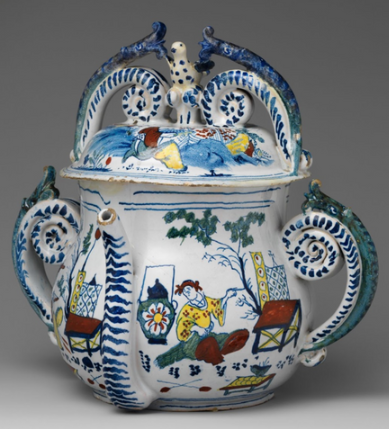Article: Possets, or How to Learn from Your Bad Haircuts

Possets, or How to Learn from Your Bad Haircuts

You might have seen possets on the menu at a trendy bistro or remembered a mention of them in Macbeth, but this classic English dish defies definition. Luxury drink, miracle cure, chilled custard; possets have morphed over the last five centuries and are still in flux.
In the 16th and 17th century, posset was one way the wealthy showed off.
In the 16th and 17th centuries, possets were rich hot drinks made with spiced cream and eggs, spiked with sack wine and sweetened with sugar. The drink was popular and most English cookbooks of the period featured several variations on posset recipes. These concoctions were heavy and warming. A recipe in The Accomplisht Cook (1660) required twenty egg yolks, rich cream, spices sack, and half a pound of double refined sugar. They required vigorous stirring and lots of time on the fire. At this time, that many eggs would cost nearly 9 pence and that much sugar would cost around 5 pence; this made the recipe far out of reach to the not-yet middle class or laborers. And was not necessarily everyday fare for the wealthy either; diarist Samuel Pepys, expected to receive posset on a frosty January evening, but the host abstained because there were not enough other guests (perhaps, to justify the expense).
Beyond its boozy-eggnog creaminess, the dish was comforting luxury. You didn’t need to have refined tastes to appreciate posset; it was often served like warm milk before bed to aid sleep or remedy illness. But wealthy hosts could use it to show off and took it a step further into decorative arts. They spurred a large market for richly decorated posset pots. While most posset pots were made of painted ceramic or bone china, craftsmen developed heirloom pieces of silver, crystal, gold, and gems.

Posset pot with cover, 1670-1710
In the 18th century, posset was everywhere: flexible and affordable.
Posset retained its popularity through the late 18th century. It appears in every English cookery book published until the 1780s. This pervasive popularity meant that posset variations abounded. Instead of being limited to sack, cream, eggs, sugar, and seasoning, posset as a definition expanded into a hot boozy custard. The Complete Family-Piece (1737) featured cheaper posset recipes with crumbled biscuits or almonds instead of eggs and cream and ale instead of sack wine. They also include variations customized to aid various illnesses. Posset had never been more customizable.
However, versatility contributed cracks to posset’s supremacy. It was more accessible, less exclusive. For the upper classes, this made it less trendy. Besides, it was old-fashioned. Instead, diners turned to similar compositions like Syllabubs (Which Austen mentions in Lesley Castle). These puddings could be served hot or cold, liquid or set with cream, which gave hosts room to show off their personalities. Tea was on the rise as well, and in 1784 the tax on it was slashed over 100%, making it more affordable and popular. By the Regency period, posset appeared to be in peril.
In the 19th century, posset made its age its whimsical strength.
While wine was the beverage of choice at well-laid Regency tables, posset was still included in contemporary cookery books. In 1827, Oxford Night Caps was published as a guide to the beverages served at the University. It included a recipe for “Rum Booze, or Egg Posset” which followed the classic hot-boozy-custard formula, but used rum instead of wine as an optional addition that would make the drink “very intoxicating.” Possets stretched their flexibility once again. They became less restorative and more intoxicating for heady scholars.
As part of this transition, posset became whimsical. William Kitchiner was the Regency celebrity chef and published The Cook’s Oracle, first in 1817, which was an international bestseller. It was largely a traditional cookery book, with quotes from Milton and Pope in the introduction. But it also included cutting-edge modern recipes, such as the first published recipe for potato crisps, or “potatoes fried in slices or shavings,” alongside older standbys and cookery advice.
The sack posset recipe is special. It is listed frankly alongside recipes for raspberry wine and instructions on how to bottle beer. But it’s a song:
The only other rhyming recipe in the book is “Mr. Gay’s Receipt to stew a Knuckle of Veal,” which isn’t written out in quotes, making it more of a mnemonic poem than a song. Mr. Gay’s recipe follows two regular recipes for stewed veal knuckle, so cooks don’t have to engage with the poem if they want to cook veal. So why is the posset set up so strangely?
Posset is persistent. It’s patient. It seems archaic and impossible, but it’s also just a boozy custard which is very easy to understand. It’s not trendy; it’s just fun! Regency posset stood in for an ancient (aristocratic) culinary tradition that could now hold space for variability, and it has maintained that status since.
In the 20th century, posset became festive and nostalgic.
In 1903, Edward Spencer published The Flowing Bowl: A Treatise on Drinks of All Kinds And of All Periods in London. He returned to the Elizabethan definition and described posset as “a medicated drink of some antiquity” yet included Sir Fleetwood’s recipe as a sort of scholar’s drinking song, with choruses of “Sir Fleetwood! Sir Fleetwood!” In 1911, The New York Times published Sir Fleetwood’s recipe, attributing it to 1743, as an ancient Christmas tradition that “probably has not been made recently.” But the convoluted tradition carried on beside plum pudding instructions.

In the later 20th century, posset was almost exclusively understood as an archaic 18th century drink of curdled milk and wine, similar to a clarified milk punch. No eggs in sight, just cooks in costume. Sometimes, lemon and sugar were included. It seemed, that posset was effectively dying a slow death.
And then it evolved again.
In the 21st century, possets learned from their past and got cold.
Contemporary possets have been on their Eras tour. They’ve learnt over the centuries how to adapt to modern tastes, and are all the better for it. Possets now contain no sack wine. They are a fantastic cold, bright dessert and we have Jill Dupleix to thank.
In 2003, Dupleix published Very Simple Food, and included a simple posset recipe of lemons, caster sugar, and double cream. I wrote to her to find out where the inspiration came from, and she cites a letter to her Times column asking for a lemon posset recipe. Inspired by Gary Rhodes and Robert Carrier, she departed from tradition for a “modern” posset of chilled citrus pudding.
Nigel Slater described Jill Dupleix’s lemon posset “a version of a medieval one” and connected it with Christmas festivities. (Thanks, 20th century). In 2004, Dupleix described possets and syllabubs in a Christmas column as “some dishes that you want to make just for their names.” (Sir Fleetwood’s 19th century whimsy persists).
By 2007, posset was a “precursor to trifle” and a quick summer dessert. (Okay 18th century, I’ve learned from my mistakes). Abundant recipes for the custardy cold dessert version followed, from chefs like Yotam Ottolenghi and Thomasina Miers. American chefs began to imitate this citrus-forward posset variation.
But bartenders wouldn’t let go of boozy possets so easily. In 2009, The New York Times quotes the rhyming Barbados recipe as the inspiration behind Bruce Yung’s festive posset at The Oak Room in Manhattan. Yung uses cream without eggs to keep the drink light and spikes it with sherries and saffron for a slightly lighter eggnog alternative. Bartenders continue to try to snag the posset lineage away from chefs, like Benjamin Smith’s 2017, Sleepwalker, but for now, a posset on a menu is a popular dessert if you’re eating somewhere trendy (although the 17th-century decor hasn’t come back yet).
We could have just called these dishes citrus custards or syllabubs. They don’t look like any previous iteration of possets. But why would we want to, when the name and the legacy are waiting for us? Cookery books guide us, intimately, in the second person. They want to trust us. Whether we’ve made posset over a fire or are lactose intolerant or from a new millennium, the book doesn’t care. They want us to trust ourselves. They empower us to be in control of our festivities so long as we grate the nutmeg without shaving off our knuckles in the process.
A posset is a dish that’s always reinventing itself.
How has posset lasted this long? Maybe we have the pernicious name to thank; Dupleix is right, it’s so fun to say. Or the relative inoffensiveness of the ingredients, relative to other medieval…delicacies. But while tastes change, maybe cooks don’t. We remember creatively. We want a seat at the table we’d never have been invited to. We love to imagine that being nostalgic through foods make us instant classics. That afternoon tea will grant us scathing wit and help us hold our figures to the greatest advantage. That enjoying Prohibition cocktails will give us flapper chic and jazz verve. That ancient foods will grant us ancient friends and help us feel a little less lonely, pouring over our traditions. That the posset wants us to sing along and get drunk and not get self-conscious about it.
Here’s a posset recipe worth making, traditional or not. If you printed it on a menu, it would be familiar to a Regency guest. I like topping posset with fresh berries, balsamic glaze, and Thai basil.
Jill Dupleix’s Modern Posset Recipe
Combine 400 ml double cream with 125 grams castor sugar in a pan and bring to the boil, stirring. Boil for 3 minutes, stirring well, without allowing the cream to boil over.
Remove from the heat, add 4 tablespoonsful of lemon juice (add more to taste) and stir well. Leave to cool for 5 minutes, then stir once more, and pour into four glasses or glass bowls. Cool and refrigerate for a few hours before serving. Serves four.
Claire Carroll is a writer from New York’s Hudson Valley currently based in Cambridge. She limps well and cycles poorly. She has studied and taught at Yale University and the University of St Andrews. Currently, she is pursuing a Ph.D. in English, with a focus on Digital Humanities. She has one weird trick for perfectly poached eggs!


2 comments
You make me smile!
Kenneth H Sheffer
Thankyou for this, article -very interesting. More of these please
Jacky
Leave a comment
This site is protected by reCAPTCHA and the Google Privacy Policy and Terms of Service apply.